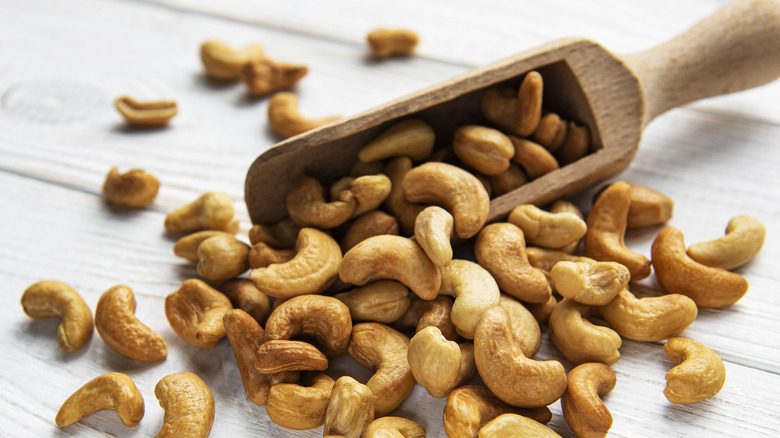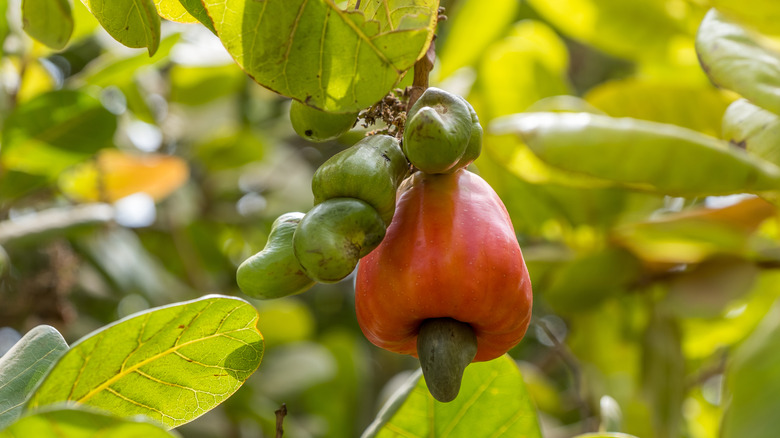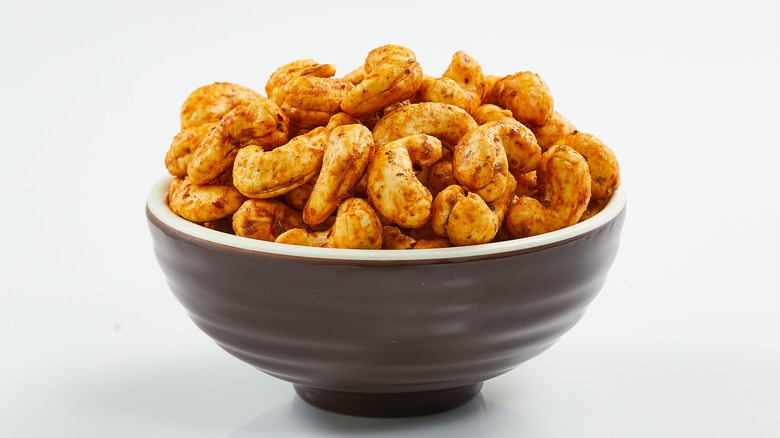Roasting Your Cashews Is The Key For The Best Texture Results
We all love "nutty" tips for eating, especially when they lead to crave-worthy snacking with deep pockets of nutrition. Many tree nut varieties meet or exceed that ambitious food ideal — even if they aren't actually real nuts. Believe it or not, the fan-favorite cashew, though routinely sold as a nut, is really a seed.
The cashew plant, known scientifically as Anacardium occidentale, has origins in Brazil, which still produces large shares of the world's cashew supply, along with India, Vietnam, Côte d'Ivoire, Indonesia, and more. Though various portions of the plant get siphoned off for industrial use, it's the cashew plant's lovable kidney-shaped drupe seed that revels in culinary fame.
To embrace the best of what cashews have to offer, it's crucial to get the texture just right. And to do that, you might want to take things into your own hands, literally. Instead of buying them "ready to eat" from the package or bin, consider roasting them yourself. That's where you'll reach the pinnacle of unique crunchy-yet-buttery texture and earthy flavor only existing in cashews.
Why roast a cashew?
Roasting cashews brings out their full natural flavor and ensures the fresh, snappy texture you crave. Sure, you can buy cashews already roasted, but there are advantages to doing it yourself. You may have noticed a slight oily sheen to commercially packaged cashews, which can subdue the texture and inherent rich flavor while adding unneeded salt and calories. Purchasing them already roasted can also considerably raise the cost and limit your ability to customize the nuts with unique flavorings of your own choosing.
Buying cashews "raw" reduces the chance of over-processing, which could potentially affect the extraordinary health benefits of this crooked little crunchy dynamo. Healthline notes that a single ounce of unroasted, unsalted cashews harbors five grams of protein, a striking 67% Daily Value (DV) of copper, and noteworthy amounts of fiber, magnesium, manganese, zinc, phosphorus, iron, and more.
Cashews hold a few more surprises, notably involving the "raw" categorization. Truly raw cashews, as plucked from the tree, contain the toxin urushiol. It's unsafe for consumption, triggering a skin reaction similar to poison ivy, which happens to contain the same toxic substance. When you buy cashews "raw" in the store, they've already been cooked at a processing plant to remove those toxins from the cashew kernels. Though not technically raw anymore, they've still yet to be cooked post-production, meaning you still have the opportunity to roast them yourself.
Ways to roast a cashew for earthy goodness
Now that you're inspired to roast your own cashews, here are a few ideas for maximizing texture and flavor. The first thing to consider is more about water than heat. Many chefs recommend soaking the nuts in slightly brined water for at least two hours, draining, and pat-drying prior to roasting. This really brings out the flavor, amps up the crunchiness, and helps any added flavorings soak into the cashews.
Get creative and toss them with sweet maple syrup, honey, or spices such as curry powder, rosemary, cinnamon, garlic, or smoky mixtures of paprika and ground cumin. You can also add salt and oil if desired. Next, choose your heat. The easiest option is to line a baking sheet with whole cashews and pop it into a standard or toaster oven. Particularly if using a dark-colored pan, cover it with foil or parchment paper first.
Opinions differ on heat levels and roasting times. Slow-roasting advocates suggest setting the oven to 200 degrees Fahrenheit and roasting for about an hour, tossing gently every few minutes to ensure even browning. The alternative for faster results is a 350-degree oven for up to 12 minutes, checking and stirring at five-minute intervals. Smaller countertop ovens will take much less time because the cashews are closer to the heat source. You can also roast cashews with a stovetop, microwave, or air fryer — times, techniques, and results will vary based on power levels and machinery.


